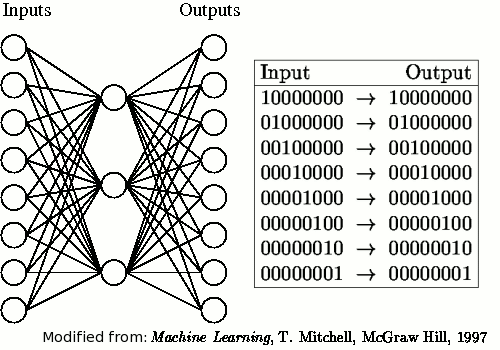
SNNS has been installed on Helios in /ai/snns. The executables
are located in /ai/snns/bin. A PDF of the user manual is located
in /ai/snns/doc. You will have to download it to your lab machine
to view it since the lab machines do not have X-Windows capabilities. A large
set of examples is provided in /ai/snns/examples.
There are four primary types of example files: the network definition (.net),
the training data (.pat), the configuration for the graphical tool (.cfg) and
the script for the command line tool (.bat). We will be looking at the
encoder example in particular for this lab. The encoder neural
network is what is known as an 8-3-8 network because it has 8 input nodes,
3 hidden nodes and 8 output nodes. The expected input for the network is
an 8-bit binary string with one 1 bit and seven 0 bits. The expected output
is identical to the input. The challenge for the network is feeding this data
through just three hidden nodes, so it cannot do a 1-to-1 mapping from input
to output. The following image summarizes the 8-3-8 problem:

To test this network, log into Helios and create a subdirectory for this lab. Copy the following files to your subdirectory:
/ai/snns/bin/batchman -f encoder.batIt should take about 10-20 training cycles before the training is done. The results are written to a file called
encoder.res. In this file,
there is one 3-line entry per training example. It shows the training data,
the output
pattern (should match the training data) and the errors for each output bit.
There will be 8 such entries in the file since we have 8 training patterns.
The trained network is written to encoder.trained.net. The actual
learned information is stored in the "Unit definition section" and the
"Connection definition section". The weights are listed in the "Connection
definition section" in edge-list format where the target column is the
destination node and the source column contains a list of source:weight pairs.
For example, if you are looking for the weight of the edge from i to j, you
would look first for j in the target column, then for i:weight in the source
column of j's row.